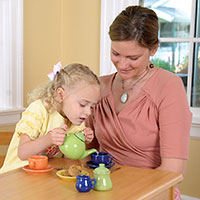 Maria Montessori noticed that children between the ages of two and six years are particularly drawn to learning the Practical Life skills that help them develop control over their physical actions. You may have noticed that your young child wants to do things the “right” way, taking particular pleasure in being able to “do it myself.” This is also the age when children most easily learn what we might call “good manners.”
Maria Montessori noticed that children between the ages of two and six years are particularly drawn to learning the Practical Life skills that help them develop control over their physical actions. You may have noticed that your young child wants to do things the “right” way, taking particular pleasure in being able to “do it myself.” This is also the age when children most easily learn what we might call “good manners.”
Don’t Assume, but Teach and Encourage
The lessons of Grace and Courtesy are included in the Montessori Practical Life curriculum: how to carry a chair and put it down quietly, how to greet a visitor to the classroom and offer refreshments, how to walk and talk quietly, how to wait for help without interrupting, etc. The Montessori teacher greets each child individually in the morning and also personalizes the farewells.
Children take great pride in being able to behave in ways we adults often expect, but may have forgotten to teach them. How often have you wiped your child’s face or nose without thinking, rather than helping her learn how to do it? In The Secret of Childhood, Montessori wrote about the children’s response to a lesson she gave them:
One day I decided to give the children a slightly humorous lesson on how to blow their noses. After I had shown them different ways to use a handkerchief …they broke out into applause. … I had no idea that such small children would applaud so enthusiastically. …I had perhaps touched a sensitive spot in their little social world. Children have a particular difficulty in blowing their noses. Since they are constantly being scolded on this score, they are sensitive about it. … But no one really teaches them how they should blow their noses.
Not only is it important to teach manners, but practicing your own courteous behavior helps to reinforce the lessons. Your tone of voice, your attitude, and method of delivery will be imitated by your children…the reminders may be humorous or astonishing as you hear your own words “out of the mouths of babes.”
Simple but not Easy
Dr. Montessori’s primary message to both teachers and parents was to “respect the child.” This seemingly simple rule, when incorporated into the life of homes and schools, can foster peace and congeniality at home, in the larger community, and, ultimately, in the world.
Today, because of our busy schedules and other priorities, we sometimes forget even the most simple courtesies. It’s easy to include these basics in your home routine:
- Greet your family calmly and individually with a “good morning” while making eye contact and giving a pat or a hug. Making this connection will help the day go better for everyone.
- Greet your child directly every time you re-unite: after school, on the phone, or in the evening. In similar fashion, make your “good-byes” specific and personal.
- Table manners are another important place to practice respect:
- Wait for all to sit before beginning to eat.
- Ask for something to be passed.
- Don’t talk with food in your mouth.
- Use a napkin to wipe your mouth.
- Ask to be excused before leaving the table.
- Include “please,” “thank you,” and “excuse me” at the appropriate times.
- Practice family rules that help avoid conflict such as waiting your turn, knocking on closed doors before entering, not interrupting someone who is busy, etc.
Solving Disagreements Respectfully
Children in a Montessori class learn ways to resolve conflict and hurt feelings. At home, similar methods can be implemented. Teach your children to be verbal rather than physical in these situations. For example, “Your brother knocked down your blocks? Look in his eyes and tell him how you feel.”
Your children can learn how to resolve disagreements without you. In some schools and families, the offended child begins by presenting the other child with a “peace rose,” signaling the need to resolve the hurt feelings. Then they take turns stating what happened and how they feel. The goal is to understand and feel friendly again. You might use some designated token in your home such as an artificial flower or heart paperweight just for this purpose.
When conflicts arise, ask children to “work it out among yourselves.” If they are unable to do so, rather than take sides, set appropriate limits. For example, you might temporarily separate the children and put the blocks away for the rest of the day.
Spreading Good Feelings
Learning basic polite behavior makes everyone feel good. Good manners make day-to-day routines more pleasant. Your home’s atmosphere of love and respect creates kind, generous, and caring people. It really is simple: When you treat children with respect, they learn respect.
 Montessori blog Montessori blog
Montessori blog Montessori blog

http://ciprofloxacin.life/# where can i buy cipro online